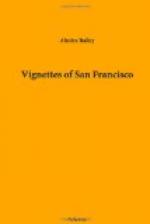Poppies and lupine and many others are the flower tradition of California but they are not what I mean here. It is an impression of mine that San Francisco more than any other city has taken the traditional plants and flowers of other sections and made them into a composite that makes up the plant atmosphere of this city.
Take roses and geraniums and callas, none of which are epochal because they are always at hand. But with old Mrs. Deacon Rogers in Connecticut who nursed her calla through the long winter that she might take it to church on Easter Sunday, the calla was history.
Even the camellia San Franciscans take very philosophically. It has not, for instance, the supremacy that Dumas gives it in “Camille.” In Sacramento they feature it more and an Easterner who saw them picking it in branches instead of single flowers, exclaimed: “Why, they think they’re oleanders.”
The plant and flower atmosphere of a community is very important. Some child is now growing up in the city, who some day will be far away when there will come to him a whiff, perhaps of acacia, and in an instant there will come surging over him all the feel and urge and thrill and wistfulness and dreams of his childhood, and he will be once more in the atmosphere of San Francisco. It will not include winter and summer but an all-round-the-year-ness, it will not mean a flower, but flowers, cherry blossoms from Japan, acacia from Australia, and the best from everywhere which all together will mean to him — San Francisco.
The smell of the acacia, which he knew as the wattle, inspired Kipling to write those words
“Smells are surer than sounds or sights
To make your heart strings crack.”
Perhaps many others see with me this difference between San Francisco and the rest of the country, as though nature here expresses herself in bounty more than in resurrection. Oh, well, whether it be “lilac time” or “all the time” to each locality there is its own beauty and, as for me, I have yet to find, in all my travels, the “place that God forgot.”
It Takes All Sorts
“Hey, hey,” called the tall, nervous man with the fat, little wife, waving his arms at the conductor for fear he would be carried past his corner.
“It takes all sorts of people to make a world,” remarked the sensible-looking woman beside me.
It is not the first time that I have been impressed with the philosophy of those words. Who said them first, I wonder. “It takes all sorts of people to make a world.” That is, if we only had one sort or even a number of sorts we would have no world. To make a world there must be all sorts, including the funniest folks we ever knew.
I looked from the sensible woman with her well-chosen clothes to the woman across the way. This second woman was a sort of dressed-up-and-no-place-to-go type, with a squirt of Cashmere Bouquet in the center of her handkerchief. And nothing on that went with anything else she had on. And a hat which one knew was a hat, because it was on her head, otherwise it might have passed for almost anything.




